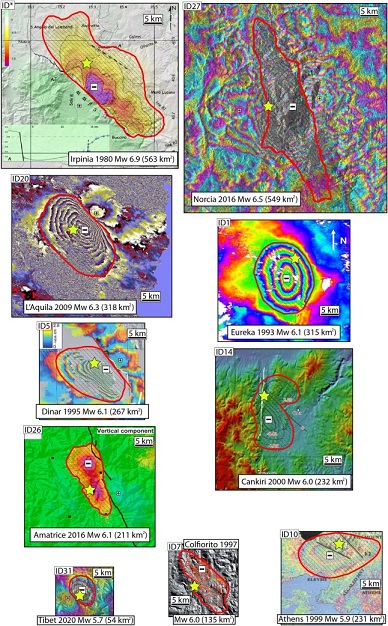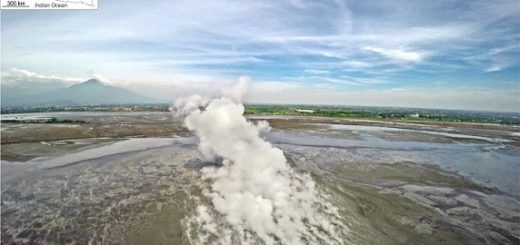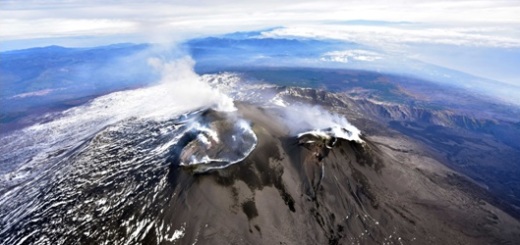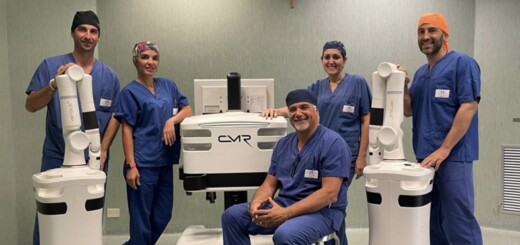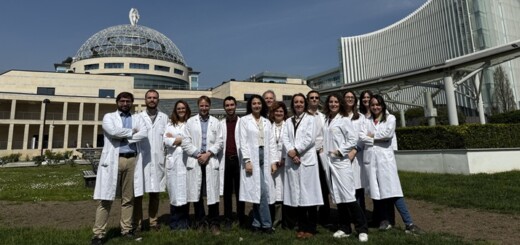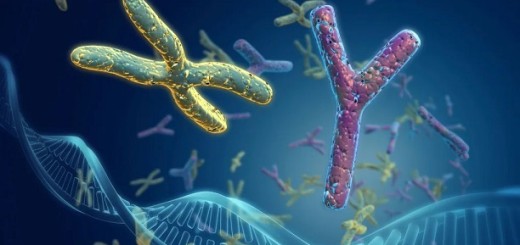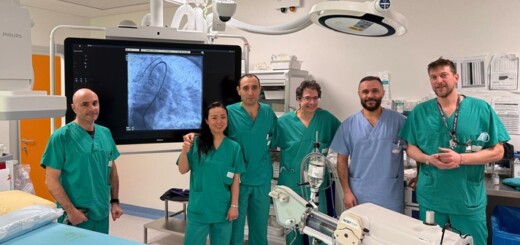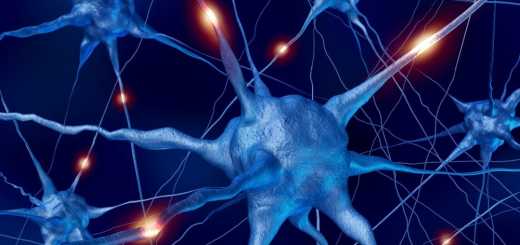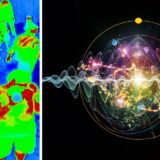Interferometria satellitare per individuare l’impronta digitale dei terremoti

Dall’analisi delle immagini satellitari si riconoscono le aree a maggiore intensità sismica di un terremoto
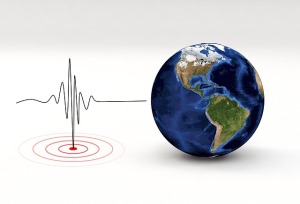
Roma, 17 maggio 2021 – Attraverso le immagini ottenute dall’interferometria satellitare, un team di ricercatori dell’Università Sapienza di Roma e dell’Istituto Nazionale di Geofisica e Vulcanologia (INGV) ha analizzato l’“impronta digitale” dei terremoti attraverso il riconoscimento della deformazione del suolo che accompagna un evento sismico.
Gli scienziati, infatti, sono riusciti a stimare con precisione le dimensioni e a riconoscere l’area dove si concentrano gli scuotimenti più violenti che accompagnano i terremoti. Lo studio “The epicentral fingerprint of earthquakes marks the coseismically activated crustal volume” è stato appena pubblicato su Earth Science Reviews.
Le immagini ottenute con la tecnica InSAR (Interferometric Synthetic Aperture Radar) consentono di rilevare la deformazione cosismica (ovvero, la deformazione istantanea e permanente causata dal terremoto) delimitando l’area epicentrale dove si è concentrato lo spostamento maggiore, attraverso l’analisi della deformazione del terreno attorno alla faglia attivata durante un terremoto.
“Nella ricerca abbiamo analizzato 32 eventi sismici, con l’obiettivo di confrontare i campi di deformazione in termini di forma, estensione spaziale e volumi di crosta terrestre coinvolti sia dalla mobilizzazione che dal contemporaneo attraversamento da parte delle onde sismiche, e il corrispondente tipo e magnitudo di terremoto” spiega Carlo Doglioni, Presidente dell’INGV e Professore della Sapienza.
“La dimensione dell’area di superficie terrestre deformata rilevata da InSAR per terremoti magnitudo uguale o maggiore di 6 è sempre maggiore di 100 km2, mentre è anche oltre 550 km2 per terremoti di magnitudo di circa 6.5. Inoltre, il confronto tra InSAR e le accelerazioni di picco del suolo documenta un maggiore scuotimento all’interno delle aree che subiscono una maggiore deformazione verticale”.
“Dal 1993, con i dati InSAR è stato analizzato un lungo elenco di eventi sismici, sempre crescente grazie all’incremento del numero dei satelliti, al miglioramento della qualità di sensori SAR, e delle tecniche InSAR nelle aree continentali – affermano Patrizio Petricca, ricercatore della Sapienza, e Christian Bignami dell’INGV – Con esse è possibile rilevare la deformazione cosismica, delimitando l’area epicentrale dove si è concentrato lo spostamento maggiore. Al di fuori di quest’area, a parte fenomeni di amplificazione locale, lo spostamento del suolo diminuisce, determinando l’attenuazione dello scuotimento sismico”.
“La conoscenza di queste manifestazioni della Terra aiuta a focalizzare più specificatamente la prevenzione sismica nelle future aree epicentrali, aiutando a calibrare la valutazione della pericolosità sismica in cui il movimento verticale gioca un ruolo rilevante nell’aumentare un maggiore scuotimento orizzontale e quindi maggiori danni. Perché i terremoti torneranno: in media in Italia si generano circa 20 terremoti distruttivi al secolo”, conclude il Presidente Carlo Doglioni.
Link allo studio:
The epicentral fingerprint of earthquakes marks the coseismically activated crustal volume”
Patrizio Petricca, Christian Bignami, Carlo Doglioni (2021). Earth Science Reviews.
doi: https://doi.org/10.1016/j.earscirev.2021.103667
*******
The fingerprint of earthquakes identified with satellite interferometry
From the analysis of satellite images, the areas with the greatest seismic intensity of an earthquake are recognized
Rome, May 17, 2021 – Through the images obtained by means of satellite interferometry technique, a team of researchers from the Sapienza University of Rome and the Istituto Nazionale di Geofisica e Vulcanologia (INGV) analyzed the “fingerprint” of earthquakes through the recognition of the ground deformation that accompanies a seismic event.
Scientists, in fact, have been able to estimate its dimensions and recognize the area where the most violent shaking accompanying earthquakes are concentrated. The study “The epicentral fingerprint of earthquakes marks the coseismically activated crustal volume” has just been published in ‘Earth Science Reviews’.
The InSAR (Interferometric Synthetic Aperture Radar) data allow to detect the coseismic deformation (that is, the instantaneous and permanent deformation caused by the earthquake) delimiting the epicentral area where the greatest displacement is concentrated, through the analysis of the deformation of the ground around the fault activated during an earthquake.
“In the research we analyzed 32 seismic events, with the aim of comparing the deformation fields in terms of shape, spatial extension and volumes of the Earth’s crust involved both by the mobilization and the simultaneous crossing by seismic waves, and the corresponding type and earthquake magnitude” explains Carlo Doglioni, President of INGV and Professor at Sapienza University.
“The size of the deformed Earth’s surface area detected by InSAR for earthquakes with a magnitude of 6 or greater is always greater than 100 km2, while it is also over 550 km2 for earthquakes with a magnitude of about 6.5. Furthermore, the comparison between InSAR and the peak ground accelerations documents greater shaking within the areas that undergo greater vertical deformation”.
“Since 1993, with the images given by InSAR, a long list of seismic events has been analyzed; this list is always growing thanks to the increase in the number of satellites and to the improvement of the quality of SAR sensors and InSAR techniques in continental areas – the researchers Patrizio Petricca (Sapienza University) and Christian Bignami (INGV) state – With them it is possible to detect the coseismic deformation, delimiting the epicentral area where most of the displacement is concentrated. Outside this area, apart from phenomena of local amplification, the ground displacement decreases, resulting in the attenuation of the seismic shaking”.
“Knowing these Earth manifestations helps to focus more specifically on seismic prevention in future epicentral areas, helping to calibrate the assessment of seismic hazard in which vertical movement plays a relevant role in increasing greater horizontal shaking and therefore greater damage. Earthquakes will return: on average, in Italy about 20 destructive earthquakes are generated per century”, concludes President Carlo Doglioni.
Link allo studio:
The epicentral fingerprint of earthquakes marks the coseismically activated crustal volume”
Patrizio Petricca, Christian Bignami, Carlo Doglioni (2021). Earth Science Reviews.
doi: https://doi.org/10.1016/j.earscirev.2021.103667
